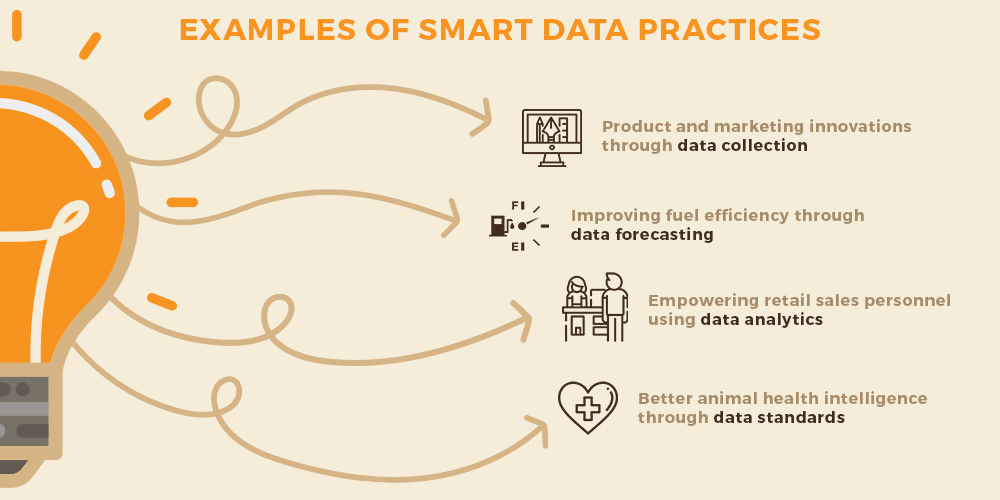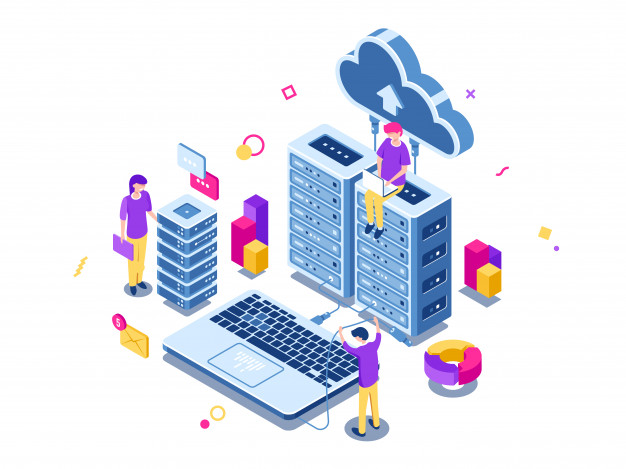
More and more organizations are realizing the importance of data and the types of data that can be tapped to provide the best customer experience and improve products and services. This has led a few data-first companies to formulate their own set of data practices. And these smart data practices are changing the way these businesses operate and are setting precedence for times to come. Read this blog to know about the smart data practices that you can adopt in your business.

We live in a world in which “smart-” is becoming a prefix for everything desirable and advanced. In the near future, it will become the new normal. Much of this smartness is powered by the enhanced understanding we develop of the way people and things work. This happens through the collection and analysis of data about every intent, event, and interaction that takes place—essentially, what is known as Big Data analytics.
Examples of smart data practices

Here are four examples of how organizations from various industries are challenging the paradigm through the way they view and use data.
1. Smart data marketing
Since their creation in 1886, Coca Cola has been at the forefront of many creative, product and packaging innovations. As a company that does not own its end-to-end distribution, Coke’s biggest challenge is possibly data collection at an individual level. This is something they are addressing through ultra-smart, high tech vending machines.
Turning big data into smart data
In 2017, Coke put out over 40,000 “freestyle”, self-serve vending machines that allowed customers to mix and match drinks. Based on intelligence collected from the activities at these machines, AI recommended that they launch a new drink—the Cherry Sprite soda. Another example is Coke On, a loyalty platform they are launching in Japan. The AI inside these vending machines runs a loyalty platform, allowing customers to collect reward points and use them to win free drinks on these machines. The AI uses point-of-sale POS and historical data to calculate the loyalty score of customers, predict their preferences and assess the inventory situation before offering a choice of free drinks.
2. Improving fuel efficiency through data forecasting
Fuel expenses make for nearly 30% of the total operating costs of airlines, making its reduction a very lucrative problem to solve. Stocking just the right quantities is key to managing costs—too little and valuable time is lost in refueling delays; too much and storage costs increase. In 2016, Southwest Airlines, for whom fuel was its second largest cost head, decided to tackle this problem head on.
Their annual fuel expenses were $4-6bn, a sum so huge that even a small percentage point improvement was significant. To begin with, they started aggregating data from multiple systems: their procurement system, fuel management platform, and enterprise data. They used time series regression modeling and neural networks on historical records of monthly fuel consumption by scheduled and unscheduled flights for tankering and alternate fuels to predict future consumption. According to Doug Gray, the then director of analytics at Southwest, they built eight different predictive models that put out 9600 forecasts per airport per month, resulting in significant savings. They also realized that they would save money by buying fuel in bulk from a single Southern California vendor than from multiple vendors. This change, when effected, brought additional savings.
Figure out what those key metrics are and then align every single one of your business analytics projects with one or more of those metrics.
Doug Gray, Director – Data ANALYTICS, SOUTHWEST AIRLINES
3. Empowering retail sales personnel using data analytics
Once upon a time, the salesperson on the department store floor was the backbone of the retail business. But with the advent of technology, their role has changed significantly. In fact, with models like Amazon Go being piloted successfully, there are even questions about whether salespersons are necessary.
This debate aside, there are many ways in which tech advancements—particularly using data — can empower salespersons to derive more value for the company and leave the customer with a great experience. For example, through real-time dashboards on tablets that arm salespersons with all relevant information to close a sale: from personalized insights about repeat customers to suggestions for alternatives, cross-selling, and upselling. Another would be assisted, live-from-home shopping where customers needn’t be present in the store physically but communicate with salespersons online to make purchases.
4. Better animal health intelligence through data standards
What role does tech have to play in a zoo? Turns out, an elephantine one! According to Robert Erhardt, CTO of the Zoological Society of San Diego, a zoo is several businesses rolled into one.
Big data examples in real life
Robert says, “We have front-of-house things like ticket sales, merchandise sales and food service sales, and point-of-sale and inventory systems to support all of those. Then you have catering opportunities with people using the zoo as a venue for events. Then you get into the next layer, which is animal care. That’s where I’ve had the most challenge and the most interest from a technology perspective.”
The management and care of animals (including rare or endangered species) is heavily dependent on what we know about them and how well we’re able to respond in case of an emergency. The San Diego zoo wanted to set new standards in this domain by making the best use of all the data collected by them.
The zoo was collecting data from its client information system, ID/tracking tags on the animals and the animal collection management system. However, most of the data collection was paper-based and no particular data standards were followed. “Let’s say somebody made an observation. Like ‘the panda cubs were squirrely today’—what does that even mean? This is why we need data standards.” says Erhardt.
His team wanted to build the animal care information system of the future—the Zoological Information Management System (ZIMS). So the zoo authorities invested in defining data standards to ensure that it could be used by any zoo around the world. This standard was then sent to subject matter experts and after fine-tuning, presented to the Association of Zoos and Aquariums (AZA). As a result, zoos now have a universal data standard for research and analytics and a great way to share best practices in animal care.
With more and more organisations realizing the importance of data and the types of data that can be tapped to provide the best customer experience and improve products and services, smart data practices will continue to evolve. The first step towards adopting a smart data practice is to move towards being a data-first organisation. This means developing clarity towards the goals and how it can be achieved through data. Here’s a quick primer to get you started on your journey.
If you need any help in developing smart data practices for your business, schedule a meeting with our consultants now.


